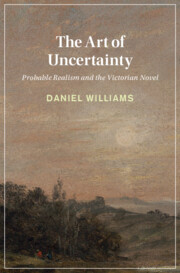Book contents
- The Art of Uncertainty
- Cambridge Studies in Nineteenth-Century Literature and Culture
- The Art of Uncertainty
- Copyright page
- Epigraph
- Contents
- Illustrations
- Acknowledgments
- Introduction
- Part I Provisional Judgments
- Part II Probable Realisms
- Coda
- Notes
- Bibliography
- Index
- Cambridge Studies In Nineteenth-Century Literature And Culture
Introduction
The Bounds of Uncertainty
Published online by Cambridge University Press: 29 February 2024
- The Art of Uncertainty
- Cambridge Studies in Nineteenth-Century Literature and Culture
- The Art of Uncertainty
- Copyright page
- Epigraph
- Contents
- Illustrations
- Acknowledgments
- Introduction
- Part I Provisional Judgments
- Part II Probable Realisms
- Coda
- Notes
- Bibliography
- Index
- Cambridge Studies In Nineteenth-Century Literature And Culture
Summary
The Introduction provides an overview of the book’s argument about how novels in nineteenth-century Britain (by George Eliot, Wilkie Collins, William Thackeray, and Thomas Hardy) represented modes of thinking, judging, and acting in the face of uncertainty. It also offers a synopsis of key intellectual contexts: (1) the history of probability in logic and mathematics into the Victorian era, the parallel rise of statistics, and the novelistic importance of probability as a dual concept, geared to both the aleatory and the epistemic, to objective frequencies and subjective degrees of belief; (2) the school of thought known as associationism, which was related to mathematical probability and remained influential in the nineteenth century, underwriting the embodied account of mental function and volition in physiological psychology, and representations of deliberation and action in novels; (3) the place of uncertainty in treatises of rhetoric, law, and grammar, where considerations of evidence were inflected by probability’s epistemological transformation; and (4) the resultant shifts in literary probability (and related concepts like mimesis and verisimilitude) from Victorian novel theory to structuralist narratology, where understandings of probability as a dual concept were tacitly incorporated.
Information
- Type
- Chapter
- Information
- The Art of UncertaintyProbable Realism and the Victorian Novel, pp. 1 - 36Publisher: Cambridge University PressPrint publication year: 2024
